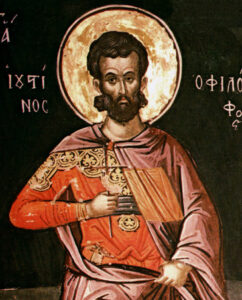
Saint Justin, Martyr
Commemorated on June 1
Actually it would be more accurate to say that Christ found him – an interesting story. After that he became a prolific writer, the first great Apologist * for the Christian Faith, one of the most significant figures of early Christianity. We’ll come to all that.
- I’m sure you all know that an Apologist is someone who explains and defends the Faith, not someone who “apologizes” for being a Christian!
But first, on behalf of the Antiochian Archdiocese of North America, to which I belong, I want to ask Saint 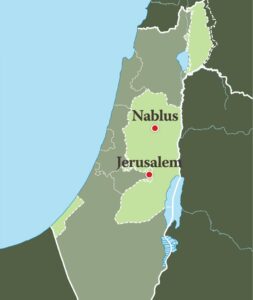 Justin to forgive us. He was one of our own. He came from Palestine (of Greek parentage), born at the beginning of the Second Century AD in the town now called Nablus (in Old Testament times it was “Shechem”), about forty miles north of Jerusalem.
Justin to forgive us. He was one of our own. He came from Palestine (of Greek parentage), born at the beginning of the Second Century AD in the town now called Nablus (in Old Testament times it was “Shechem”), about forty miles north of Jerusalem.
So how many churches in our Archdiocese are named after Saint Justin? Zero. In fact in all North America I can locate only one Saint Justin Martyr Orthodox Church, in Jacksonville, Florida, whom may God bless for remembering this great saint.
Justin’s Early Life
We know little about his earliest life, except that he was raised in a pagan home. They must have been well-to-do, for he was educated in philosophy in various major schools including those in Alexandria and Ephesus.
Young Justin was a “seeker”. He sought the truth * – the truth about Ultimate Reality, about God, if there was a God. He studied the popular philosophies of the time. At first he thought the Stoics had the answers. Then he leaned towards Pythagoreanism, then the Peripatetics, and after that Platonism. None of them satisfied him.
- God bless him for that. See last week’s Post.
Justin was just giving up on Platonism when one day he went for a walk along the seashore. (He was probably in Syria at the time.) An old man joined him and instructed him for a long while and convinced Justin that true knowledge of God cannot be gained by human seeking, through philosophy. The only way we can know God is by God’s revelation of Himself, through the Prophets who were inspired by God’s Holy Spirit, and finally through Jesus Christ, God Incarnate.
Justin wrote that it was almost a mystical experience – made no less so by the fact that he never saw the old man again, never even learned his name. All his life he wondered. It seemed as if the man had been sent to him in that lonely place, to tell him just what he needed to hear at just the right time in his life, when he was most discouraged by mere philosophy, most open to Christianity.
What else moved him to become a Christian? The courage and steadfastness of the Christian martyrs. What did they possess that they were willing to die for it?
Saint Justin as a Christian
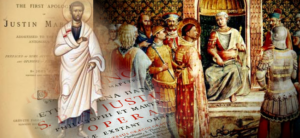
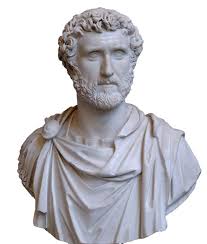
In his thirtieth year Justin was Baptized. He continued to dress in the clothing of a Greek philosopher. Following that tradition, he never married. But now he saw himself as a Christian philosopher. Soon, his heart now aflame with the truth of the Faith, he began to write. He became a rigorous Apologist for Christianity against secular philosophies and paganism: Twelve major works, of which unfortunately only three survive in their entirety. A Dialogue with Trypho, (probably an actual debate, since Trypho was a well-known Jewish rabbi) and two Apologies written to the Roman Emperor Antoninus Pius explaining the Faith, in the hope of putting an end to popular misconceptions of Christianity, so that he would then put an end to persecution of Christians – and Antoninus did! He directed that Christians not be disturbed so long as they broke no laws.
We know more of Sant Justin’s writings through others who quoted him.
He traveled extensively, devoted his energy to the missionary work of the Church, of evangelizing the pagans, drawing on his own personal pagan background and experience.
Saint Justin on the Divine Liturgy (Eucharist)
Now let’s give some time to this singular topic, partly to show the clarity of Saint Justin’s writing, but chiefly to deal with a matter that is of great interest today.

What was early Christian worship like? Did it consist of free-form “make it up as you go” services, with Holy Communion now and then? This has been the style of worship for a long time in the “free church” Protestant tradition. Now even those in classical Protestantism are headed that way – what a formerly Protestant (now Orthodox) friend of mine called “the Baptistification of American Protestantism”. This is having some effect even in American Roman Catholicism.
The answer is: Ancient Church worship was liturgical with the Holy Eucharist every Sunday. It had a fixed form. How do we know this? Because Saint Justin described it.
What else would we have expected? Christian worship came from people who knew only Jewish liturgical services. Go to a traditional Jewish synagogue service, and the connections with our Divine Liturgy are obvious. This is the origin of our Pro-Anaphora. Then came the the part where we celebrate the Holy Eucharist: they prayed for the coming of the Messiah. (I felt like shouting, “He’s here! He’s here!” but I didn’t.)
I’m wandering. Back to Saint Justin:
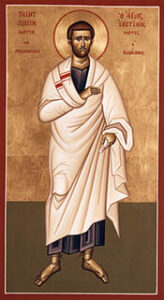 Justin settled in Rome. It was in about the year 150 that he wrote to the Emperor describing in some detail the Sunday Liturgy (the “Mass” as Roman Catholics came to call it), as it had been passed down to them from earliest times – which, please note, were not that long before. *
Justin settled in Rome. It was in about the year 150 that he wrote to the Emperor describing in some detail the Sunday Liturgy (the “Mass” as Roman Catholics came to call it), as it had been passed down to them from earliest times – which, please note, were not that long before. *
- Justin became a Christian about a hundred years after the death and resurrection of Christ. To put this in personal context, I have very clear memories of my parents describing the world as they knew it a hundred years ago, in the 1920s.
In what follows here, you will find almost everything to be familiar. Our Orthodox/Catholic Liturgical Tradition has not changed.
__________________________
From Saint Justin’s First Apology, chapters 65 and 66. His words are in italics:
And on the day called Sunday, all who live in cities or in the country gather together to one place, and the memoirs of the apostles [Epistle, Gospel] or the writings of the prophets [sadly, we have lost this] are read, as long as time permits; then, when the reader has ceased, the president [presiding Bishop or Priest] verbally instructs, and exhorts to the imitation of these good things [the sermon or homily]. Then we all rise together and pray, and, as we before said, when our prayer is ended, bread and wine and water are brought, and the president in like manner offers prayers and thanksgivings [the Anaphora], according to his ability * and the people assent, saying Amen; and there is a distribution to each, and a participation of that over which thanks have been given, and to those who are absent a portion is sent by the deacons.
- Why did he not describe the words of the Anaphora? Because no-one except the Baptized were allowed to be present then. This was not for non-Christian “consumption”.
And they who are well to do, and willing, give what each thinks fit; and what is collected is deposited with the president, who succours the orphans and widows and those who, through sickness or any other cause, are in want, and those who are in bonds and the strangers sojourning among us, and in a word takes care of all who are in need. [The early Christians were noted for their charitable work to all – a new thing under the sun.]
But Sunday is the day on which we all hold our common assembly, because it is the first day on which God, having wrought a change in the darkness and matter, made the world; and Jesus Christ our Savior on the same day rose from the dead. For He was crucified on the day before that of Saturn (Saturday); and on the day after that of Saturn, which is the day of the Sun, having appeared to His apostles and disciples, He taught them these things, which we have submitted to you also for your consideration.
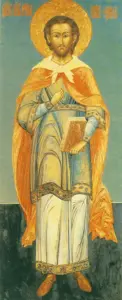
This section describes Baptism and how the newly Baptized are united with the congregation, with a simplified description of the Liturgy:
But we, after we have thus washed [Baptized] him who has been convinced and has assented to our teaching, bring him to the place where those who are called brethren are assembled, in order that we may offer hearty prayers in common for ourselves and for the baptized person, and for all others in every place, that we may be counted worthy, now that we have learned the truth, by our works also to be found good citizens and keepers of the commandments, so that we may be saved with an everlasting salvation.
Having ended the prayers, we salute one another with a kiss. There is then brought to the president of the brethren bread and a cup of wine mixed with water; and he taking them, gives praise and glory to the Father of the universe, through the name of the Son and of the Holy Spirit, and offers thanks at considerable length for our being counted worthy to receive these things at His hands.
And when he has concluded the prayers and thanksgivings, all the people present express their assent by saying Amen. This word Amen answers in the Hebrew language to ge’noito [so be it].
And when the president has given thanks *, and all the people have expressed their assent, those who are called by us deacons give to each of those present to partake of the bread and wine mixed with water over which the thanksgiving was pronounced, and to those who are absent they carry away a portion.
- “Eucharistized”, the blessing of the Bread and Wine, which begins “Let us give thanks unto the Lord”.
And this food is called among us Eucharistia, of which no one is allowed to partake but the man who believes that the things which we teach are true, and who has been washed with the washing that is for the remission of sins, and unto regeneration, and who is so living as Christ has enjoined.
For not as common bread and common drink do we receive these; but in like manner as Jesus Christ our Saviour, having been made flesh by the Word of God, had both flesh and blood for our salvation, so likewise have we been taught that the food which is blessed by the prayer of His word, and from which our blood and flesh by transmutation are nourished, is the flesh and blood of that Jesus who was made flesh.
A few notes:
1 If you read carefully, you saw that Saint Justin, writing from Rome, placed the Exchange of Peace before the “Offertory”, where it remains today in the Roman/Western rite. If he had been in the East he would have placed it within the Anaphora, as it is in our Eastern Orthodox rite.
2 In ancient times the Kiss of Peace was exchanged by the people. Over the centuries, for reasons unknown, it came to be reserved for the clergy. In recent times in some places it has been restored to the people. (Our late Metropolitan Philip, of blessed memory, urged this.) The Kiss of Peace is not some modern kicky “feel good” invention. It is an ancient liturgical action, intended to express that all the people should be at peace with each other before they receive the Holy Eucharist.
3 The Eucharist was received only by the Baptized who believe the Faith, the person “who has been convinced and has assented to our teaching.” This is why to this day we do not have “open Communion” in the Orthodox Church and (officially, at least) the Roman Catholic Church.
4 Actual wine was used for the Eucharist. A little water was mixed with the wine, a practice which continues in Eastern Orthodox, Roman Catholic and most Anglican churches.
5 It was clear that the Bread and Wine truly become the Body and Blood of Christ – and on a permanent basis, so that Holy Communion can be taken to those who are ill. This practice continues in Eastern Orthodox, Roman Catholic and many Anglican churches. Protestant churches reject this practice, believing the bread and wine are only “reminders” of Christ’s death, or that He is present in the bread and wine only during the service.
To sum up, in ways both great and small, we Orthodox continue in the Liturgical Tradition of the earliest Church.
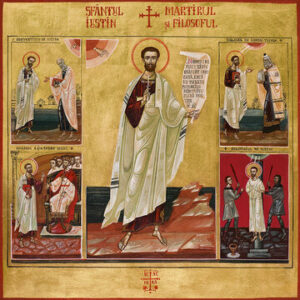
The Martyrdom of Saint Justin and those with him
At this time there was not continual persecution. However, the possibility was always there, waiting… waiting.
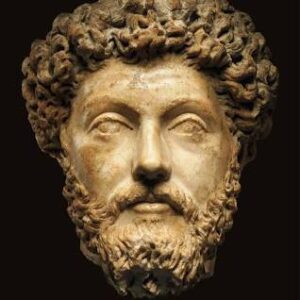
In about the year 165 Saint Justin was in Rome, teaching “Christian philosophy”. As was the custom, he set up a school to that end and gathered students. In a debate he bested a pagan, Crescens, who took his revenge and reported him to the authorities. By now Antoninus was gone. The new Emperor Marcus Aurelius was apparently not a persecutor of Christians, but he did allow it.
What happened next was preserved in the Court Records:
“The Prefect Rusticus says: Approach and sacrifice, all of you, to the gods. Justin says: No one in his right mind gives up piety for impiety. The Prefect Rusticus says: If you do not obey, you will be tortured without mercy. Justin replies: That is our desire, to be tortured for Our Lord Jesus Christ, and so to be saved, for that will give us salvation and firm confidence at the more terrible universal tribunal of Our Lord and Savior. And all the martyrs said: Do as you wish; for we are Christian, and we do not sacrifice to idols. The Prefect Rusticus read the sentence: Those who do not wish to sacrifice to the gods and to obey the emperor will be scourged and beheaded according to the Laws. The holy martyrs glorifying God betook themselves to the customary place, where they were beheaded and consummated their martyrdom, confessing their Savior.”
 Martyred with Saint Justin were some of his students – Chariton, Euelpistus, Hierax, Peonus, Valerian, Justus; and one woman Charita. Their relics are today in the Jesuit’s Church in Valletta, on the island of Malta.
Martyred with Saint Justin were some of his students – Chariton, Euelpistus, Hierax, Peonus, Valerian, Justus; and one woman Charita. Their relics are today in the Jesuit’s Church in Valletta, on the island of Malta.
_________________________
“The whole Church of God is adorned with the wisdom of your divine words, O Justin; The world is enlightened by the radiance of your life. By the shedding of your blood, you have received a crown. As you stand before Christ with the angels, pray unceasingly for us all!”
Kontakion of Saint Justin Martyr
- _________________________
Sources consulted in writing this article: 1 Orthodox Wiki; 2 Website of Saint Justin Martyr Roman Catholic Church, Houston Texas; 3 Word on Fire Catholic Ministries; 4 Orthodox Church in America; 5 New Advent Catholic Encyclopedia
Next Week: The Woman of Samaria, I know I talked about her twice berfore, in 2024 and 2020, but I just love this story.
Week after Next: The Ascension – the feast of our future
P.S. Rather to Saint Justin’s surprise, I suspect, June 1 is now also “The First Day of LGBTQ Pride Month”. Six years ago I wrote two Posts on the subject. Should you be interested, here’s the first: